An exhibition of 19th Century stereograms and 20th century holographic stereograms drawn from the Jonathan Ross Collection.
As a change from my policy of showing holography as art, this exhibition draws mainly on commercial material from my hologram collection and compares and contrasts the images made in the 1980s and 90s with stereoscopic photographs from the second half of the 19th century.
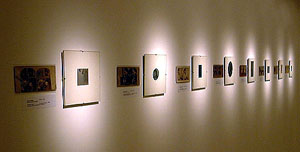
Since the early days of photography we have been preoccupied with the desire to depict the world in three dimensions and in naturalistic colour. Almost simultaneously with the discovery of photography stereoscopic techniques were introduced, whereby a pair of photographs, one representing the viewpoint of each eye, were taken, either at once or sequentially, and subsequently viewed in a device which enabled the viewer to fuse the two images into one three-dimensional one. These 'stereographs' gained early popularity and the patronage of Queen Victoria and Prince Albert at the Great Exhibition of 1851 and, during the second half of the 19th century came to be manufactured in the millions by thousands of photographic companies around the world. The majority of stereoviews were produced as sepia prints, but a higher -priced range were hand coloured, often with great skill, by the miniaturists whose business they had usurped.

In the second half of the twentieth century, holography emerged as a new three dimensional imaging technique, made possible by the invention of the laser. Classic holograms are recorded directly from the subject, but a hybrid of cinematography and holography, called a holographic stereogram, was developed in the 1970s. This technique requires a sequence of film frames, taken from different perspectives, which can be condensed into a kind of holographic movie, revealing its action as one moves in front of it. Initially these were monochromatic images with a rainbow hue, but eventually full-colour techniques were developed, using colour separated film footage or video, and mass-production was enabled through embossing relief images into plastic foil. The image of Shakespeare will be familiar to many people from its use on a bank card and other images have been used on magazine covers and greetings cards and CD covers.
There is not necessarily a holographic equivalent for every type of stereoscopic image, but in some instances the similarities and differences between 19th century stereo photos and 20th century holograms can be revealing. In the 19th century a 'Bird's Eye View' for Lovejoy & Foster meant a photograph taken from the top of a tall building, but in 1991, David Burder was able to charter a helicopter to enable him to film Manhattan from the air.
 In the 19th century a handsome black man in the United States was unlikely to be represented as anything but a domestic servant but by 1991 Michael Jordan was a worldclass athlete on the cover of a major American magazine. It comes as no surprise that both 19th century male photographers and 20th century holographers should take pictures of pretty girls and of their infant children;
In the 19th century a handsome black man in the United States was unlikely to be represented as anything but a domestic servant but by 1991 Michael Jordan was a worldclass athlete on the cover of a major American magazine. It comes as no surprise that both 19th century male photographers and 20th century holographers should take pictures of pretty girls and of their infant children;

Patrick Boyd's work, however, illustrates a particularly late 20th century angst. In 'Virtual Dialogues', his newborn son is immediately equipped with a virtual reality headset and in 'Temporary Measure', his four-armed secretary is physically overwhelmed with information.
To my mind stereographs enable a type of time travel; looking at them one is transported instantly to the viewpoint of the original photographer in quite a different way to with monocular photographs. In holographic stereograms, a few seconds of time from a different era are captured which we can subsequently replay back and forth at our own speed. The appearance of early stereographs and the method of viewing them conjures up the very flavour of their own era. No doubt holograms will do the same for future generations.
Jonathan Ross, February 2000
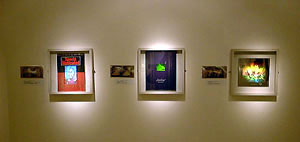
Work in the exhibition:
James Elliott
Untitled 1850s
Hand-coloured stereograph

Patrick Boyd
'Temporary Measure' 1988
Achromate embossed holographic stereogram
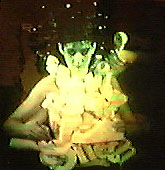
James Elliott
'Grand Dad' 1850s
Hand-coloured stereograph
Applied Holographics CFC
'Michael Jackson' 1989
Full-colour embossed holographic stereogram
B.Kuhn Editions
'Nos Mondaines' 1860s
Tissue stereograph
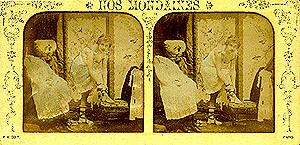
Applied Holographics
'Nasty Boy' 1992
Full-colour embossed holographic stereogram
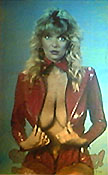
Lake Price
'Don Quixote' 1860s
Hand-coloured stereograph
Applied Holographics
'Shakespeare' 1988
Full-colour embossed holographic stereogram
Excelsior Stereoscopic Tours
'Untitled' late 19th c
Sepia stereograph
Hologram Industries
'Jennifer Beale' 1989
Achromate embossed holographic stereogram
Charles Goodman
'Little Nell' 1860s
Hand-coloured stereograph
Applied Holographics CFC
'Toy Shop' 1989
Full-colour embossed holographic stereogram
James Elliott
'One Too Many' 1860s
Hand-coloured stereograph
Sharon McCormack/ ABNH
'Prince - Diamonds & Pearls' 1991
Full-colour embossed holographic stereogram on CD cover
E.Lamy
Untitled (Pierrot) 1860s
Tissue stereograph
Sharon McCormack/ ABNH
'Clown' 1991
Full-colour embossed holographic stereogram
Theatrical Stereoscopic
Publishing Co.
'Untitled' 1880s
Sepia stereograph
Peter Claudius
'Sylvia' 1980
120° integral stereogram
W.H.Jackson
'Marshall Pass under Mt.Ouray' 1870s
Sepia stereograph
Multiplex Co.
'Train' late 1970s
mini 120° integral stereogram
Lovejoy & Foster
'Bird's Eye View of Chicago' 1870s
Sepia stereograph
David Burder/Laza Holograms
'Aerial view of Manhattan' 1991
Reflection holographic stereogram
Anon.
'The Darky's Vanity' 1860s
Hand-coloured stereograph
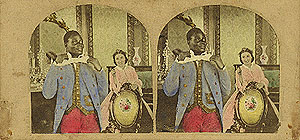
American Banknote Holographics
'Michael Jordan' 1991
full-colour embossed holographic stereogram on magazine
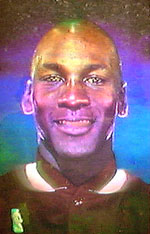
Anon.
'Mysteries of Crinoline' 1860s
Hand-coloured stereograph
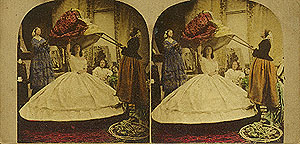
Hamad Butt
'Familiars' 1995
Reflection holographic stereogram on book
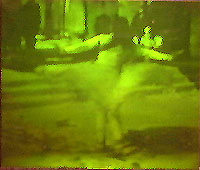
James Elliott
'Frank' 1860s
Hand-coloured stereograph

Patrick Boyd
'Virtual Dialogues' 1993
Full-colour nickel shim holographic stereogram

Underwood & Underwood
'Consider the Lilies' 1901
Sepia stereograph
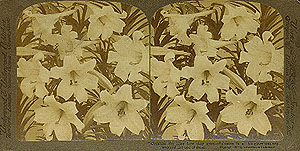
Rudie Berkhout
'New Flowers' 1978
Flat integral stereogram
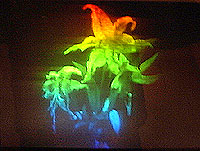
Anon.
Untitled (Dog) 1850s
Sepia stereograph
Spatial Imaging
'Party Puppy' 1996
Full-colour embossed holographic stereogram
Anon.
Untitled (Cauliflower) 1860s
Sepia stereograph
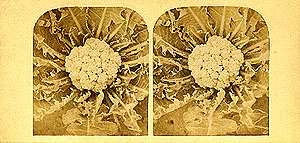
Spatial Imaging
'Tulip' 1996
full-colour embossed holographic stereogram

Anon.
'Scene in a Ballet' 1850s
Hand-coloured stereograph
Spatial Imaging
'Duet' 1996
Full-colour embossed holographic stereogram
On Friday March 10th a reception was held for "STEREO PAIRS'.
Below are some of the visitors who attended.
Larger versions are available by clicking on the selected image.



